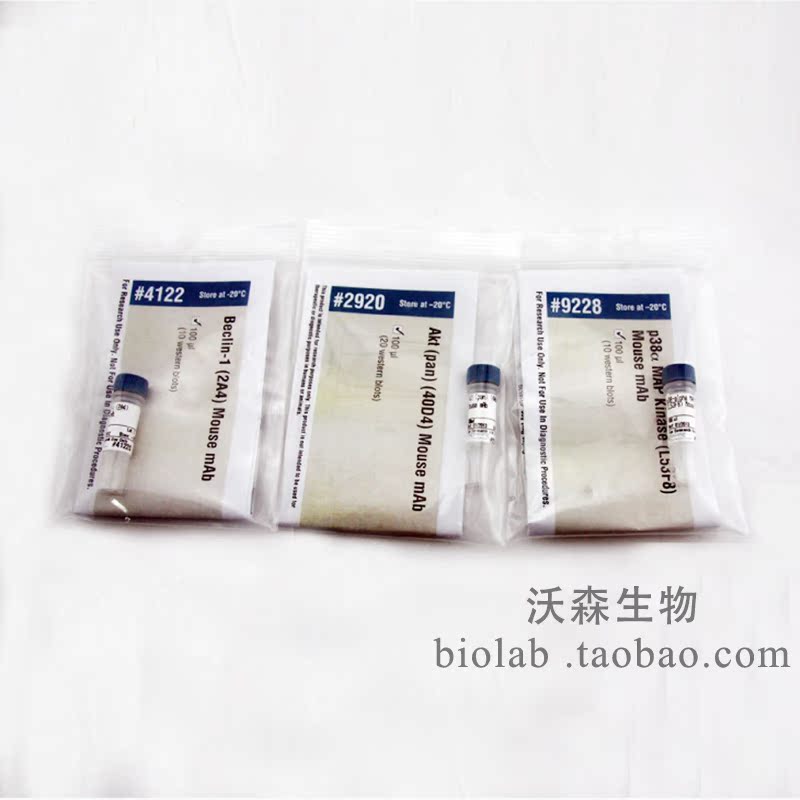英文名称: Akt (pan) (40D4) Mouse 抗体


Akt (pan) (40D4) Mouse mAb #2920
Size
| 2920S | 100 ul ( 20 western blots ) | |
| 2920 | carrier free & custom formulation / quantity |
Dilution
Species-Reactivity
Sensitivity
MW (kDa)
Isotype
| W | 1:2000 | Human, Mouse, Rat, Monkey | Endogenous | 60 | Mouse IgG1 |
| IP | 1:50 | ||||
| IHC-P | 1:250 | ||||
| IF-IC | 1:50 | ||||
| F | 1:50 |
Species cross-reactivity is determined by western blot.
Applications Key: W=Western Blotting, IP=Immunoprecipitation, IHC-P=Immunohistochemistry (Paraffin),IF-IC=Immunofluorescence (Immunocytochemistry), F=Flow Cytometry
Specificity / Sensitivity
Akt (pan) (40D4) Mouse mAb detects endogenous levels of total Akt protein. This antibody does not cross-react with other related proteins.
Source / Purification
Monoclonal antibody is produced by immunizing animals with a synthetic peptide at the carboxy-terminal sequence of human Akt.
Western Blotting

Western blot analysis of recombinant Akt1, Akt2, Akt3 and GST proteins using Akt (pan) (40D4) Mouse mAb (upper) and GST (91G1) Rabbit mAb #2625 (lower).
Western Blotting

Western blot analysis of extracts from NIH/3T3, C6 and COS cells using Akt (pan) (40D4) Mouse mAb.
IHC-P (paraffin)

Immunohistochemical analysis of paraffin-embedded human breast carcinoma using Akt (pan) (40D4) Mouse mAb in the presence of control peptide (left) or Akt (pan) Blocking Peptide #1085 (right).
IHC-P (paraffin)

Immunohistochemical analysis using Akt (pan) (40D4) Mouse mAb on SignalSlide Phospho-Akt (Ser473) IHC Controls #8101 (paraffin-embedded LNCaP cells, untreated (left) or LY294002-treated (right)).
Background
Akt, also referred to as PKB or Rac, plays a critical role in controlling survival and apoptosis (1-3). This protein kinase is activated by insulin and various growth and survival factors to function in a wortmannin-sensitive pathway involving PI3 kinase (2,3). Akt is activated by phospholipid binding and activation loop phosphorylation at Thr308 by PDK1 (4) and by phosphorylation within the carboxy terminus at Ser473. The previously elusive PDK2 responsible for phosphorylation of Akt at Ser473 has been identified as mammalian target of rapamycin (mTOR) in a rapamycin-insensitive complex with rictor and Sin1 (5,6). Akt promotes cell survival by inhibiting apoptosis through phosphorylation and inactivation of several targets, including Bad (7), forkhead transcription factors (8), c-Raf (9), and caspase-9. PTEN phosphatase is a major negative regulator of the PI3 kinase/Akt signaling pathway (10). LY294002 is a specific PI3 kinase inhibitor (11). Another essential Akt function is the regulation of glycogen synthesis through phosphorylation and inactivation of GSK-3α and β (12,13). Akt may also play a role in insulin stimulation of glucose transport (12). In addition to its role in survival and glycogen synthesis, Akt is involved in cell cycle regulation by preventing GSK-3β-mediated phosphorylation and degradation of cyclin D1 (14) and by negatively regulating the cyclin dependent kinase inhibitors p27 Kip1 (15) and p21 Waf1/Cip1 (16). Akt also plays a critical role in cell growth by directly phosphorylating mTOR in a rapamycin-sensitive complex containing raptor (17). More importantly, Akt phosphorylates and inactivates tuberin (TSC2), an inhibitor of mTOR within the mTOR-raptor complex (18,19).
- Franke, T.F. et al. (1997) Cell 88, 435-7.
- Burgering, B.M. and Coffer, P.J. (1995) Nature 376, 599-602.
- Franke, T.F. et al. (1995) Cell 81, 727-36.
- Alessi, D.R. et al. (1996) EMBO J 15, 6541-51.
- Sarbassov, D.D. et al. (2005) Science 307, 1098-101.
- Jacinto, E. et al. (2006) Cell 127, 125-37.
- Cardone, M.H. et al. (1998) Science 282, 1318-21.
- Brunet, A. et al. (1999) Cell 96, 857-68.
- Zimmermann, S. and Moelling, K. (1999) Science 286, 1741-4.
- Cantley, L.C. and Neel, B.G. (1999) Proc Natl Acad Sci USA 96, 4240-5.
- Vlahos, C.J. et al. (1994) J Biol Chem 269, 5241-8.
- Hajduch, E. et al. (2001) FEBS Lett 492, 199-203.
- Cross, D.A. et al. (1995) Nature 378, 785-9.
- Diehl, J.A. et al. (1998) Genes Dev 12, 3499-511.
- Gesbert, F. et al. (2000) J Biol Chem 275, 39223-30.
- Zhou, B.P. et al. (2001) Nat Cell Biol 3, 245-52.
- Navé, B.T. et al. (1999) Biochem J 344 Pt 2, 427-31.
- Inoki, K. et al. (2002) Nat Cell Biol 4, 648-57.
- Manning, B.D. et al. (2002) Mol Cell 10, 151-62.
Application References
- Wu, M. et al. (2009) PLoS One 4, e6430. Applications: Western Blotting, IP.
- Yamada, T. et al. (2012) Oncogene , . Applications: Western Blotting.
Have you published research involving the use of our products? If so we'd love to hear about it. Please let us know!
Companion Products
- 8112 SignalStain Antibody Diluent
- 4691 Akt (pan) (C67E7) Rabbit mAb
- 4060 Phospho-Akt (Ser473) (D9E) XP Rabbit mAb
- 2965 Phospho-Akt (Thr308) (C31E5E) Rabbit mAb
- 9916 Phospho-Akt Pathway Antibody Sampler Kit
- 9940 Akt Isoform Antibody Sampler Kit
- 2938 Akt1 (C73H10) Rabbit mAb
- 2964 Akt2 (5B5) Rabbit mAb
- 3788 Akt3 (62A8) Rabbit mAb
- 8101 SignalSlide Phospho-Akt (Ser473) IHC Controls
- 1085 Akt (pan) Blocking Peptide
- 7071 Phototope-HRP Western Blot Detection System, Anti-rabbit IgG, HRP-linked Antibody
- 7074 Anti-rabbit IgG, HRP-linked Antibody
- 7720 Prestained Protein Marker, Broad Range (Premixed Format)
- 7727 Biotinylated Protein Ladder Detection Pack
- 7003 20X LumiGLO Reagent and 20X Peroxide
- 8125 SignalStain Boost IHC Detection Reagent (HRP, Mouse)
- For Research Use Only. Not For Use In Diagnostic Procedures.
DRAQ5 is a registered trademark of Biostatus Limited.
Cell Signaling Technology is a trademark of Cell Signaling Technology, Inc.

